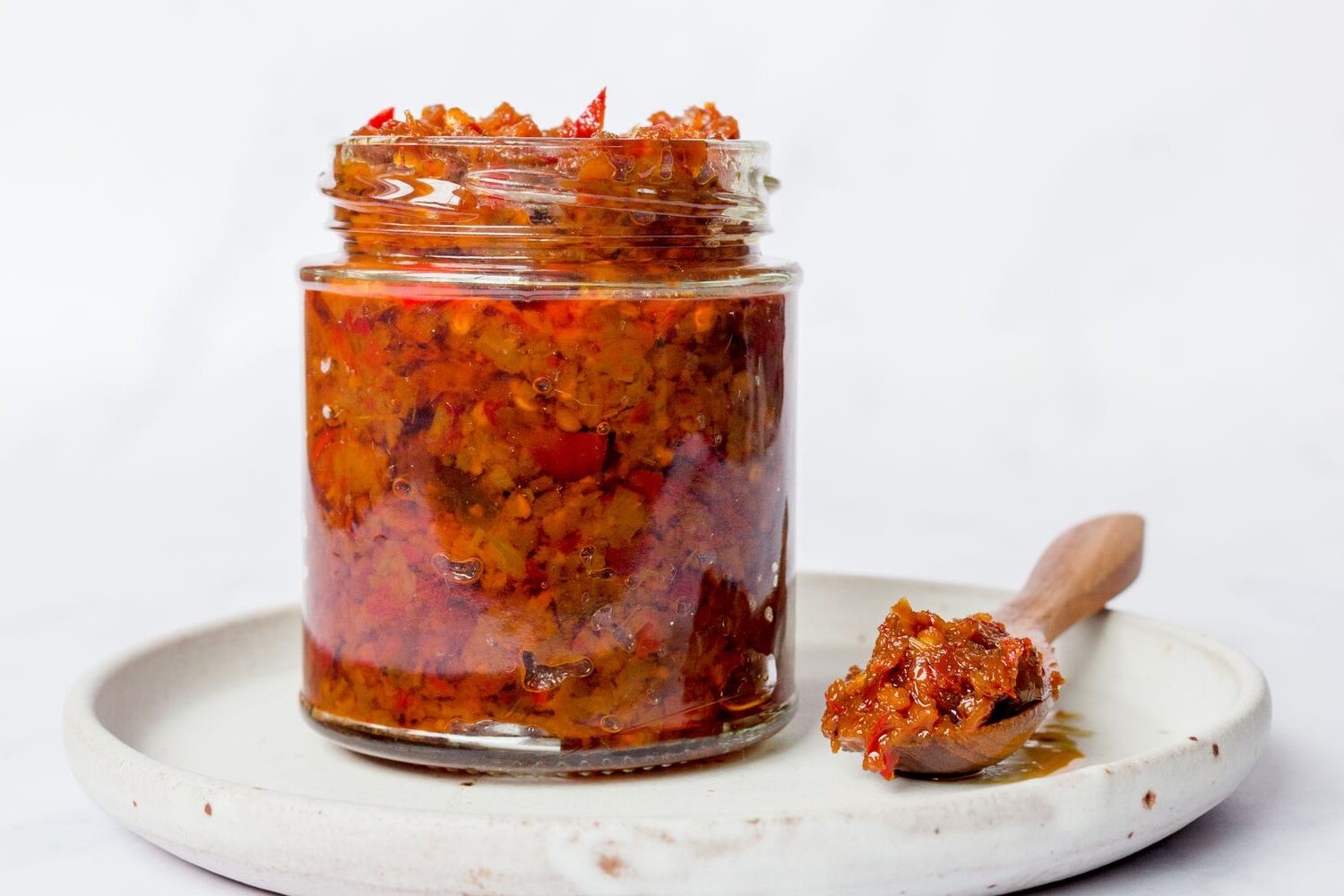Sambal sauce is a fiery and flavorful condiment that adds a punch to any dish. Originating from Southeast Asia, this versatile sauce can be used as a dip, marinade, or even a cooking ingredient. Its bold flavors come from a blend of red chilies, garlic, and tamarind, making it a must-have for spice lovers.
Tamarind paste might not be a common pantry item for everyone. It has a unique tangy flavor that is essential for authentic sambal sauce. You can find it in the international or Asian section of most supermarkets. If you can't find tamarind paste, you can substitute it with lime juice or vinegar, but the flavor will be slightly different.

Ingredients For Sambal Sauce Recipe
Red chilies: These provide the heat and vibrant color for the sauce.
Garlic: Adds a pungent and aromatic flavor.
Tamarind paste: Gives a tangy and slightly sweet taste.
Sugar: Balances the heat and acidity with sweetness.
Salt: Enhances the overall flavor of the sauce.
Vegetable oil: Used for cooking the blended mixture to bring out the flavors.
Technique Tip for Sambal Sauce
When blending the red chilies and garlic, ensure they are finely chopped beforehand to achieve a smoother consistency. This will help the mixture cook more evenly and enhance the overall texture of your sambal sauce.
Suggested Side Dishes
Alternative Ingredients
red chilies - Substitute with serrano peppers: Serrano peppers have a similar heat level and flavor profile, making them a good alternative.
red chilies - Substitute with cayenne peppers: Cayenne peppers offer a similar spiciness and can be used if red chilies are unavailable.
garlic - Substitute with shallots: Shallots provide a milder, sweeter flavor that can complement the other ingredients well.
garlic - Substitute with garlic powder: Garlic powder can be used in a pinch, though it lacks the fresh, pungent flavor of chopped garlic.
tamarind paste - Substitute with lime juice: Lime juice provides a similar tangy acidity that can mimic the flavor of tamarind paste.
tamarind paste - Substitute with vinegar: Vinegar can offer the necessary acidity, though it may lack the complexity of tamarind.
sugar - Substitute with honey: Honey adds sweetness and a slight floral note, making it a good alternative to sugar.
sugar - Substitute with brown sugar: Brown sugar provides a deeper, molasses-like sweetness that can enhance the sauce.
salt - Substitute with soy sauce: Soy sauce adds saltiness along with umami, enriching the overall flavor.
salt - Substitute with fish sauce: Fish sauce adds a salty, umami depth that can enhance the complexity of the sambal.
vegetable oil - Substitute with olive oil: Olive oil can be used as a healthier alternative, though it may impart a slightly different flavor.
vegetable oil - Substitute with coconut oil: Coconut oil adds a subtle coconut flavor that can complement the other ingredients well.
Alternative Recipes Similar to Sambal Sauce
How to Store or Freeze This Sauce
Allow the sambal sauce to cool completely to room temperature before storing. This prevents condensation from forming inside the storage container, which can dilute the sauce and affect its flavor.
Transfer the cooled sambal sauce into an airtight container. Glass jars with tight-fitting lids or BPA-free plastic containers work best to maintain freshness.
Label the container with the date of preparation. This helps you keep track of its shelf life and ensures you use the sauce while it's at its best.
Store the container in the refrigerator. The sambal sauce will keep well for up to 2 weeks when refrigerated. Always use a clean spoon to scoop out the sauce to avoid contamination.
For longer storage, consider freezing the sambal sauce. Portion the sauce into ice cube trays for easy, single-use servings. Once frozen, transfer the cubes to a freezer-safe bag or container, and label it with the date.
When ready to use, thaw the desired amount of sambal sauce in the refrigerator overnight or at room temperature for a few hours. Avoid microwaving to defrost, as this can alter the texture and flavor.
If you notice any changes in color, smell, or texture, discard the sambal sauce. Freshness is key to maintaining the vibrant flavors of this spicy condiment.
How to Reheat Leftovers
Stovetop Method: Place the sambal sauce in a small saucepan. Heat over low to medium heat, stirring occasionally to ensure even warming. This method helps maintain the sauce's texture and flavor.
Microwave Method: Transfer the sambal sauce to a microwave-safe container. Cover it with a microwave-safe lid or a damp paper towel to prevent splatters. Heat on medium power in 30-second intervals, stirring in between, until the sauce is heated through.
Double Boiler Method: Fill a pot with a few inches of water and bring it to a simmer. Place a heatproof bowl containing the sambal sauce over the pot, ensuring the bottom of the bowl does not touch the water. Stir occasionally until the sauce is warmed. This gentle method prevents the sauce from burning.
Oven Method: Preheat your oven to 300°F (150°C). Transfer the sambal sauce to an oven-safe dish and cover it with aluminum foil. Heat for about 10-15 minutes, stirring halfway through to ensure even heating.
Steam Method: Place the sambal sauce in a heatproof bowl and set it in a steamer basket over boiling water. Cover and steam for about 5-10 minutes, stirring occasionally, until the sauce is heated through. This method helps retain moisture and prevents the sauce from drying out.
Best Tools for Making Sambal Sauce
Blender: To blend the red chilies and garlic until smooth.
Pan: To cook the blended mixture and other ingredients.
Spatula: To stir the mixture while cooking.
Measuring spoons: To measure the tamarind paste, sugar, and salt accurately.
Knife: To chop the red chilies and garlic.
Cutting board: To provide a surface for chopping the chilies and garlic.
Bowl: To hold the chopped ingredients before blending.
Spoon: To help transfer the blended mixture and stir the sauce.
Stove: To provide the heat source for cooking the sambal sauce.
How to Save Time on Making This Sauce
Pre-blend ingredients: Blend the red chilies and garlic in bulk and store in the fridge for up to a week.
Use ready-made tamarind paste: Opt for store-bought tamarind paste to save time on preparation.
Cook in batches: Double or triple the recipe and store the extra sambal sauce in the fridge or freezer for future use.
Pre-measure ingredients: Measure out the sugar, salt, and vegetable oil beforehand to streamline the cooking process.
Use a food processor: A food processor can blend the ingredients faster and more efficiently than a traditional blender.

Sambal Sauce Recipe
Ingredients
Main Ingredients
- 10 pieces Red chilies seeded and chopped
- 4 cloves Garlic chopped
- 2 tablespoons Tamarind paste
- 1 tablespoon Sugar
- 1 teaspoon Salt
- 2 tablespoons Vegetable oil
Instructions
- 1. Blend the red chilies and garlic until smooth.
- 2. Heat the oil in a pan over medium heat.
- 3. Add the blended mixture to the pan and cook for 5 minutes.
- 4. Add tamarind paste, sugar, and salt. Stir well and cook for another 10 minutes.
- 5. Let it cool before serving.
Nutritional Value
Keywords
Check out these recipes too!
- Baja Sauce Recipe for Fish or Shrimp Tacos10 Minutes
- Garlic Naan Recipe30 Minutes
- Swedish Hard Tack Recipe45 Minutes
- Dutch Crunch Rolls Recipe45 Minutes
- Strawberry Glazed Pie Recipe50 Minutes
- Spanakopita Greek Spinach Pie Recipe1 Hours 15 Minutes
- Breakfast Rice Recipe30 Minutes
- Italian Rice Pie Recipe1 Hours 20 Minutes
- Cottage Cheese Bread Recipe1 Hours
- Savory Parmesan French Toast Recipe25 Minutes
- Applesauce Bread Recipe1 Hours
- Vegan Pumpkin Pie Smoothie Recipe10 Minutes


Leave a Reply